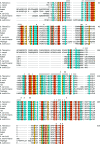The structure of Enterococcus faecalis thymidylate synthase provides clues about folate bacterial metabolism
- PMID: 22948925
- PMCID: PMC10316677
- DOI: 10.1107/S0907444912026236
The structure of Enterococcus faecalis thymidylate synthase provides clues about folate bacterial metabolism
Abstract
Drug resistance to therapeutic antibiotics poses a challenge to the identification of novel targets and drugs for the treatment of infectious diseases. Infections caused by Enterococcus faecalis are a major health problem. Thymidylate synthase (TS) from E. faecalis is a potential target for antibacterial therapy. The X-ray crystallographic structure of E. faecalis thymidylate synthase (EfTS), which was obtained as a native binary complex composed of EfTS and 5-formyltetrahydrofolate (5-FTHF), has been determined. The structure provides evidence that EfTS is a half-of-the-sites reactive enzyme, as 5-FTHF is bound to two of the four independent subunits present in the crystal asymmetric unit. 5-FTHF is a metabolite of the one-carbon transfer reaction catalysed by 5-formyltetrahydrofolate cyclo-ligase. Kinetic studies show that 5-FTHF is a weak inhibitor of EfTS, suggesting that the EfTS-5-FTHF complex may function as a source of folates and/or may regulate one-carbon metabolism. The structure represents the first example of endogenous 5-FTHF bound to a protein involved in folate metabolism.
Figures





References
-
- Anderson, A. C., O’Neil, R. H., DeLano, W. L. & Stroud, R. M. (1999). Biochemistry, 38, 13829–13836. - PubMed
-
- Anguera, M. C., Suh, J. R., Ghandour, H., Nasrallah, I. M., Selhub, J. & Stover, P. J. (2003). J. Biol. Chem. 278, 29856–29862. - PubMed
-
- Benvenuti, M. & Mangani, S. (2007). Nature Protoc. 2, 1633–1651. - PubMed
-
- Berger, S. H., Berger, F. G. & Lebioda, L. (2004). Biochim. Biophys. Acta, 1696, 15–22. - PubMed
-
- Birdsall, B., Burgen, A. S., Hyde, E. I., Roberts, G. C. & Feeney, J. (1981). Biochemistry, 20, 7186–7195. - PubMed
Publication types
MeSH terms
Substances
Associated data
- Actions
Grants and funding
LinkOut - more resources
Full Text Sources
Medical

